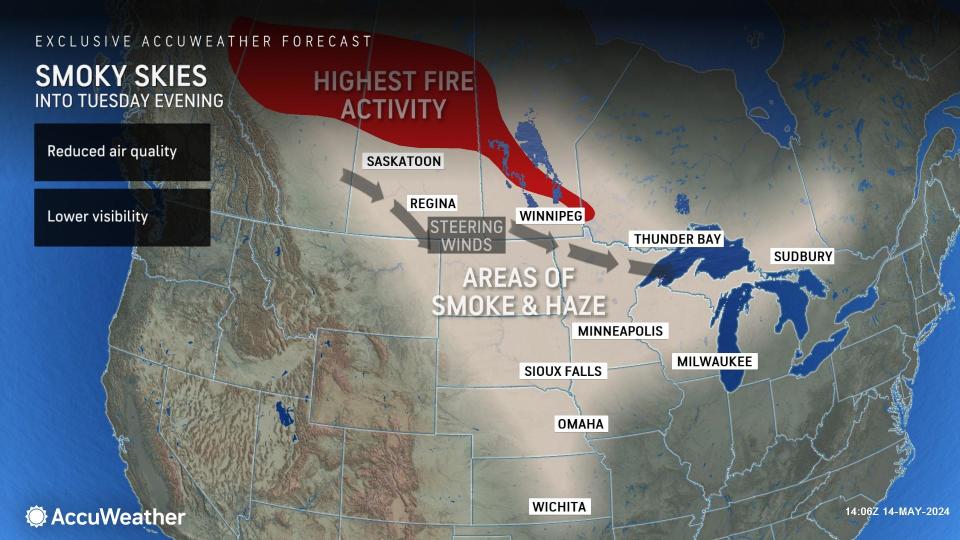Air quality in several US states threatened by growing Canada wildfires: See map
Canadian wildfires triggered air quality alerts in Montana, North Dakota, South Dakota, Minnesota, parts of Wisconsin and Iowa Sunday and Monday, and experts say there won't be much improvement in the coming months as more states could possibly be affected this summer.
"I do expect more air quality issues," said Paul Pastelok, a senior meteorologist and U.S. long-range forecaster at AccuWeather. "There'll be breaks, but the breaks will be few and in between at times in areas that are being affected even now."
According to Pastelok, the fires could keep burning until September or October. However, predicting when it will improve is difficult.
"Predicting if the air quality will improve or worsen can be difficult because of the unpredictable behavior of wildfires and factors such as wind, weather, and terrain," said the Environmental Protection Agency's Office of Media Relations and Risk Communications in a statement sent to USA TODAY. "For example, a wind that usually clears out a valley could also blow more smoke in or fan the flames, intensifying the fire and worsening smoke."

According to Pastelok, weather patterns are still "very active" in the regions being affected by the smoke, and that will help improve the quality of air, but it can change.
Like the EPA, Pastelok said the same system that can help improve air quality could also blow smoke back into the U.S.
"So it's good and bad," said Pastelok. "It can clear for a little bit and then pick back up again on the backside of it."
States impacted by air quality from wildfires
The following states saw air quality alerts:
Iowa: Monday morning, parts of the state saw air quality drop to the "unhealthy" range, reports WHO 13
Minnesota- Saw air quality alerts from Sunday to Monday night, according to a press release.
Montana- Air quality dropped on Monday, but saw improvement later in the day as surface winds began to shift, states a different press release from Montana's Department of Environmental Quality.
North Dakota- The state was put on alert Monday as smoke from the neighboring country impacted the air.
South Dakota-On Monday, South Dakota announced the alert that would stay in effect until Tuesday. It stated that the smoke could cause low visibility and increased fine particulate matter, in a press release.
Wisconsin- Parts of Wisconsin were placed on an air quality advisory on Monday, which was set to end at midnight the same day, according to previous reporting from USA TODAY.
Smoke could grow with fires
Pastelok said the smoke could get much worse going into June and July if fires start to grow.
Alberta, British Columbia, and parts of Manitoba, Ontario and Southern Ontario are "pretty dry," he said. So, if fires do grow in those areas, the Great Lakes area and parts of the far northeastern U.S. could be affected.
The wildfire season is more active than usual because of the lack of snow depth and Canada's drought situation. Because of that, "there'll be a lot of smoke in the air across Canada, and it doesn't take much to pull that smoke down. So I think we're still looking at problems here through the summer, in the northern tier in the nation, especially," said Pastelok.
However, the meteorologist doesn't believe things will be as bad as they were last year.
Side-effects of inhaling wildfire smoke
Wildfire smoke can irritate one's eyes, nose, and throat and cause:
Coughing
Chest tightness,
Shortness of breath
Dizziness
Fatigue
Particulate matter, a type of air pollutant that is made of small particles of solids or liquids that are suspended in the air, is one of the main components of wildfire smoke, as USA TODAY previously reported.
According to Yale Medicine, the particles can be 10 micrometers, PM 10, or as small as 2.5 micrometers, PM 2.5, and the smaller one poses a lot of health risks.
PM2.5 is so tiny it can easily pass people's usual defense mechanisms and dive deep into their lungs. Not only can it damage lung function, but it can also pass into the bloodstream and travel to other organs.
The following is linked to exposure to the PM 2.5:
Heart attack
Stroke,
Lung cancer
Decline in cognitive function
Wearing masks can protect one's lungs
"I think you should have masks handy if you have conditions, especially if you're very sensitive to bad air quality," said Pastelok.
The meteorologist says it's better to get masks early so stores won't be out of stock when more people need them.
"Make sure you're buying them ahead of time here because you never know when the stores might run out," he said.
He adds that folks should be paying attention to weather alerts and checking air quality.
"I recommend people look at that closely," advised Pastelok. "Especially in the northern tier, northern plains states, upper midwest, upper Great Lakes and far northern Northeast."
He adds that people should have an air purifier handy if they can afford it and to make sure their AC and ventilation systems are working before the smoke reaches them or their air quality decreases.
"Make sure they're working efficiently because you can't open the windows up because that will bring everything inside," said Pastelok.
Contributing: Karina Zaiets, Ramon Padilla, Cecilia Garzella, Yoonserk Pyun; USA TODAY
Julia is a trending reporter for USA TODAY. She has covered various topics, from local businesses and government in her hometown, Miami, to tech and pop culture. You can follow her on X, formerly Twitter, Instagram and TikTok: @juliamariegz
This article originally appeared on USA TODAY: Canadian wildfires 2024: See map of air quality impacting US states

